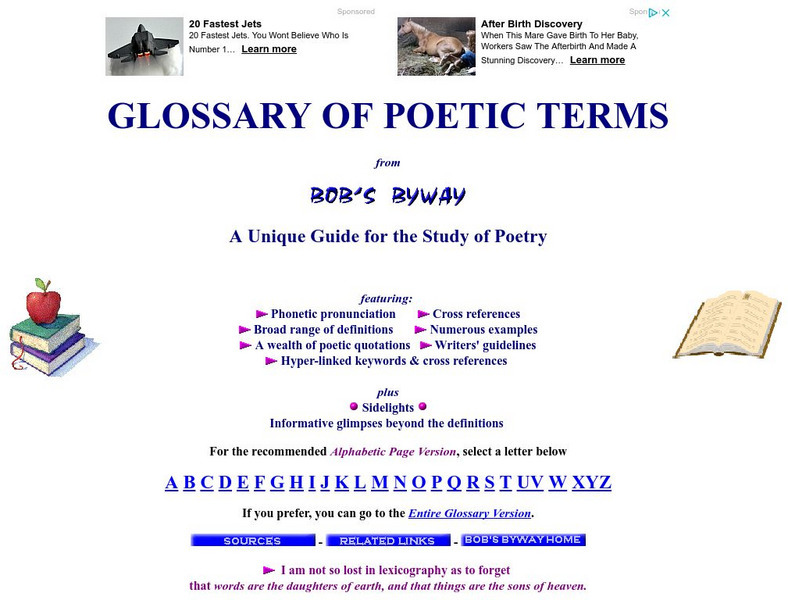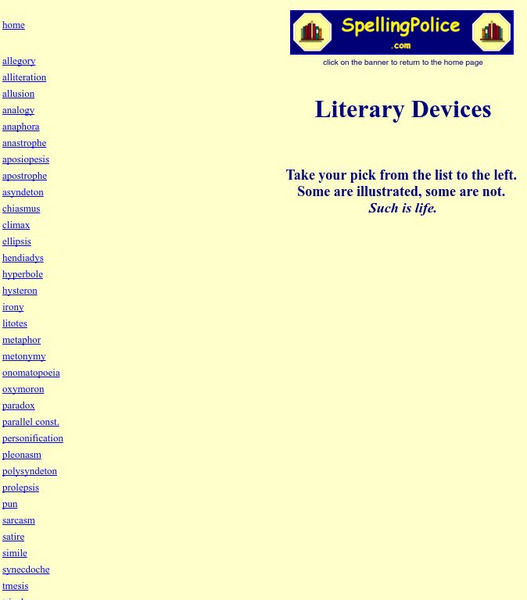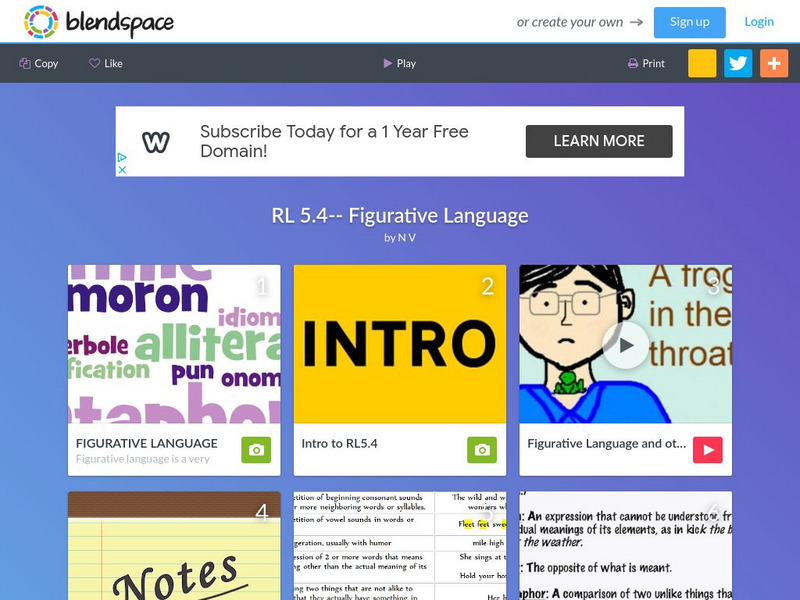Hi, what do you want to do?
Curated OER
Rock & Roll through Literary Terms: An Upbeat Lyrical Adventure
Students participate in a variety of activities surrounding Rock & Roll music, lyrics, drama and visual art and how they all help demonstrate examples of literary terms. They use Rock & Roll as an effective aid to stimulate their...
Curated OER
Use Digital Photos of Scary Things to Inspire Poetry Writing
There's nothing like a provocative image to inspire a creative writing session. In the language arts lesson presented here, middle schoolers bring in digital photos of scary objects, such as a big spider, or a hornet's nest. The pictures...
Fly Parsons
Crispin: Figurative Language Activity #1
As part of a study of figurative language Avi uses in his book, Crispin, individuals define the 10 terms listed on the activity and then locate severals examples of each in the text of the novel.
Curated OER
The Final Word
Although this lesson is based on “Final Word,” Craig Wilson’s USA Today column, the strategies could be adapted to any local columnist. After reading three articles independently, groups share observations about content and style used by...
Curated OER
Quirky Quatrain Poetry Lesson
Middle schoolers discover what a quatrain is, and are taught the three poetic devices: alliteration, hyperbole, and onomatopoeia. Everyone chooses a favorite hobby or activity, then attempts to write a poem about it. They must write two...
Curated OER
Find the Mean #1
In this numbers worksheet, students study 8 sets of numbers and determine the mean for each set. Students write their answers in the boxes provided.
Curated OER
Personalized Poetry Portfolio
Eighth graders create their own poetry portfolio containing poems that relate to Students' lives and families. The portfolio consist of the following types of poems: acrostic, diamante`, haiku, cinquain, and free verse.
Curated OER
Poetry of Abraham Lincoln
Fourth graders analyze Abraham Lincoln's poems "The Bear Hunt" and "My Childhood's Home" for word choice and deeper inquiry into the vocabulary he uses to convey emotion. They identify rhyming words and patterns in these poems. ...
Curated OER
Those Cells Look Good Enough to Eat
Students explore the parts of the cell. In this cell lesson plan, students use foods to create cell models that represent the nucleus, cytoplasm, cell membrane, mitochondria, ribosomes, vacuoles, endoplasmic reticulum, and Golgi bodies...
Curated OER
Identify Poetic Devices
In this poetic devices worksheet, students identify devices being used as alliteration, rhyme, onomatopoeia, rhyme, idiom, simile, metaphor, hyperbole or personification and explain their choice.
Curated OER
The Power of Poetry
Young scholars utilize the Internet to research figures of speech used in poetry and poetry terms
Curated OER
Georgia Performance Standards Framework for ELA Unit 6-8th grade
Eighth graders explore figurative language through the study of picture books. In this figurative language lesson plan, 8th graders listen to books and chart the figurative language that they hear. Students discuss examples in groups.
Curated OER
Bringing the Line to Life
Young scholars use different types and lengths of sentences. They write with an insight of the stylistic aspects of composition. Students use precise language including adjectives, adverbs, action verbs and specific details that convey...
Curated OER
Modern American Poetry
Pupils identify different types of literary terms in poems. They read different poems and create a packet summarizing them. They write a poem of their own and a biography of one of their favorite poets.
Novelinks
The Adventures of Tom Sawyer: Writing Strategy
How do your pupils believe others see them? Invite them to write narratives to explore the image they present to the word. The narratives, inspired by The Adventures of Tom Sawyer, are to be set at each pupil's hypothetical funeral.
Curated OER
Poetry Unit Test
In this poetry worksheet, students complete multiple choice questions on different aspects of poetry. Students complete 40 questions total.
Lumen Learning
Lumen: Boundless Communications: Deploying Style Effectively
This lesson plan focuses on rhetorical devices and how to use them effectively in public speaking. These include alliteration, antithesis, hyperbole, onomatopoeia, personification, repetition and parallelism, and simile and metaphor.
E Reading Worksheets
E Reading Worksheets: Figurative Language Worksheets
This learning module provides remediation and extra practice with identifying different types of figurative language. Reinforcement is provided through the worksheets, quizzes, video game links, and online sites for the following types...
TES Global
Blendspace: Figurative Language & Tone
A twelve-part learning module with links to texts, videos, and websites on figurative language and tone.
ClassFlow
Class Flow: Figurative Language and Sound Devices
[Free Registration/Login Required] This flipchart is intended for students in grades 4 and 5 who have been introduced to the terms simile, metaphor, hyperbole, alliteration, and onomatopoeia. The activities in the flipchart give...
Other
Bob's Byway: Glossary of Poetic Terms
Calling itself "unique," Bob's is easy to use, with cross-links throughout, phonetic pronunciation guides when necessary, and many examples and quotations. Click on the letter and scroll for the word.
Love To Know Media
Your Dictionary: Literary Terms Lesson Plan
This is a lesson plan for teaching the seven literary terms used in poetry: simile, metaphor, alliteration, imagery, hyperbole, personification, and onomatopoeia.
Other
Spelling police.com: Literary Devices
A simple list of literary terms. Click on each for a definition and examples.
TES Global
Blendspace: Rl 5.4 Figurative Language
This twelve-part learning module provides assorted references for figurative language terms. This blendspace provides reproducible charts, flash cards, a game, video tutorial lessons, and rap songs. L.9-10.5 Fig Lang/nuances




























